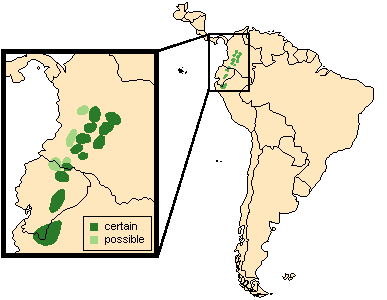![]() Return
to Perissodactyla
Return
to Perissodactyla
Classification
|
 Tapirus
pinchaque
Tapirus
pinchaque
Mountain tapir
![]()
Taxonomy
 |
 |
 |
|
Click on the pictures above for a larger view of the
photographs
|
|||
General Characteristics
Body Length: 180 cm / 6 ft.
Shoulder Height: 75-80 cm / 30-32 in.
Tail Length: 5-10 cm / 2-4 in.
Weight: 225-250 kg / 495-550 lbThe coat is thick, rough, and long-haired, with an insulating layer of underfur. Covering the thinnest skin among tapirs, the wooly hair ranges in colour from coal black to dark reddish-brown. The cheeks may be lighter. As with all species of tapir, young animals look more like reddish-brown watermelons. The white stripes and spots gradually fade from the darkening wooly brown coat, reaching adult coloration around one year of age. The lips are startlingly white, and the edges of the ears are often the same. Typical of tapirs, the nose is long and prehensile, and the eyes are small and beady. The body is round and barrel-shaped, and the short tail is stump-like.
Ontogeny and Reproduction
Gestation Period: 390-400 days
Young per Birth: 1, rarely 2.
Weaning: By 1 year.
Sexual Maturity: At about 3 years.
Life span: Up to 30 years.
Ecology and Behavior
Primarily active from late afternoon until early morning, the mountain tapir rests in thick vegetation during the day. They are surprising agile and sure-footed, and can move easily through dense plant growth. Worn paths, made by the tapirs, are the primary routes for travelling. Climbing slopes presents no problem, and, like all tapirs, are fond of bathing and wallow. Normally shy, mountain tapirs generally flee, either to water or into dense vegetation, when confronted with danger. However, if cornered they can make formidable opponents, fighting viciously. This behavior is also seen when males engage in fights over estrous females, using their well-developed teeth in an attempt to lacerate their opponent's rear legs. The main form of communication is a shrill whistle, which sounds more likely to be made by a bird than a large mammal.Family group: Solitary.
Diet: Shoots and plant stems.
Main Predators: Mountain lions, jaguar, humans.
Distribution
Mountainous terrain at elevations 2,000-4,500 m / 6,400-14,400 ft. in the equatorial Andes (Colombia, Ecuador, and Peru).

Range Map (Redrawn from Downer, 1997)
Conservation Status
The mountain tapir is considered to be an endangered species by the IUCN (1996).
Remarks
The smallest tapir species - and the only tapir that does not inhabit tropical forests - the mountain tapir lives in the high Andes, where temperatures regularly fall below freezing. As a result, this species has developed a thick, wooly coat, with hairs up to 2.5 cm / 1 inch long to keep out the cold, which gives it its other name - the woolly tapir.
Tapirus is a Latinized corruption of tapyra - the Tupi name for the tapir (the Tupis are an aboriginal tribe from the Amazon). "La Pinchaque" was a large fabulous animal believed to live in the same mountains as this tapir.
Literature Cited
Downer, C. C. 1997. Status and action plan of the mountain tapir (Tapirus pinchaque). In Tapirs - Status Survey and Conservation Action Plan. IUCN/SSC Tapir Specialist Group. Compiled by D. M. Brooks, R. E. Bodmer, and S. Matola. IUCN, Gland, Switzerland and Cambridge, UK. Available online at http://www.tapirback.com/tapirgal/iucn-ssc/tsg/action97/default.htmEisenberg, J. F., C. P. Groves, and K. MacKinnon. 1990. Tapirs. In Grzimek's Encyclopedia of Mammals. Edited by S. P. Parker. New York: McGraw-Hill. Volume 4, pp. 597-608.
Nowak, R. M. [editor]. 1991. Walker's Mammals of the World (Fifth Edition). Baltimore: The Johns Hopkins University Press.
Wilson, D. E., and D. M. Reeder [editors]. 1993. Mammal Species of the World (Second Edition). Washington: Smithsonian Institution Press. Available online at http://nmnhwww.si.edu/msw/
Additional Resources
Downer, C. 1996. The mountain tapir, endangered 'flagship' species of the high Andes. Oryx; 30(1): 45-58.
Return to Perissodactyla

![]()
© Brent Huffman, www.ultimateungulate.com |
|
|